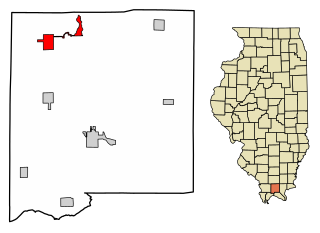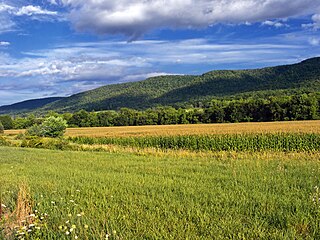
Williamson County is a county in Southern Illinois. At the 2020 census, it had a population of 67,153. The largest city and county seat is Marion.

Saline County is a county in Southern Illinois. At the 2020 census, it had a population of 23,768. The largest city and county seat is Harrisburg. This area of Southern Illinois is known locally as "Little Egypt".

Hanaford is a village in Franklin County, Illinois, United States. The population was 320 at the 2020 census. Hanaford is also known as Logan.

Thompsonville is a village in Cave Township, Franklin County, Illinois, United States. The population was 543 at the 2010 census.

Equality is a village in Gallatin County, Illinois, United States. The population was 595 at the 2010 census, down from 721 at the 2000 census. Near the village are two points of interest, the Crenshaw House and the Garden of the Gods Wilderness. Equality was the county seat of Gallatin County from 1826–1851.

Junction is a village in Gallatin County, Illinois, United States. The population was 129 at the 2010 census.

New Haven is a village in Gallatin County, Illinois, United States, along the Little Wabash River near its mouth at the Wabash River. The population was 433 at the 2010 United States Census, down from 477 at the 2000 census.

Old Shawneetown is a village in Gallatin County, Illinois, United States. As of the 2010 census, the village had a population of 193, down from 278 at the 2000 census. Located along the Ohio River, Shawneetown served as an important United States government administrative center for the Northwest Territory. The village was devastated by the Ohio River flood of 1937. The village's population was moved several miles inland to New Shawneetown.

Omaha is a village in Gallatin County, Illinois, United States. The population was 266 at the 2010 census.

Ridgway is a village in Gallatin County, Illinois, United States. As of the 2020 census, the population was 851. As of 2018, Rebecca Mitchell was the town mayor.

Elizabethtown is a village in and the county seat of Hardin County, Illinois, United States, along the Ohio River. The population was 299 at the 2010 census, down from 348 at the 2000 census. It is the least-populous county seat in the state.

Goreville is a village in Johnson County, Illinois, United States. The population was 1,049 as of the 2010 census, up from 938 at the 2000 census.

New Burnside is a village in Johnson County, Illinois, United States. The population was 211 at the 2010 census.

Long Point is a village in Livingston County, Illinois, United States. The population was 226 at the 2010 census.

New Salem is a village in Pike County, Illinois, United States. The population was 136 at the 2000 census.

Galatia is a village in Saline County, Illinois, in the United States. As of the 2010 census, the village population was 933.

Muddy is a small incorporated village located in the Harrisburg Township in Saline County, Illinois, United States. The population was 78 at the 2000 census.

Raleigh is a village in Saline County, Illinois, United States. The population was 330 at the 2000 census.

Pittsburg is a village in Williamson County, Illinois. The population was 572 at the 2010 census.

LeRoy Township is a township in Bradford County, Pennsylvania, United States. It is part of Northeastern Pennsylvania. The population was 718 at the 2010 census.
























